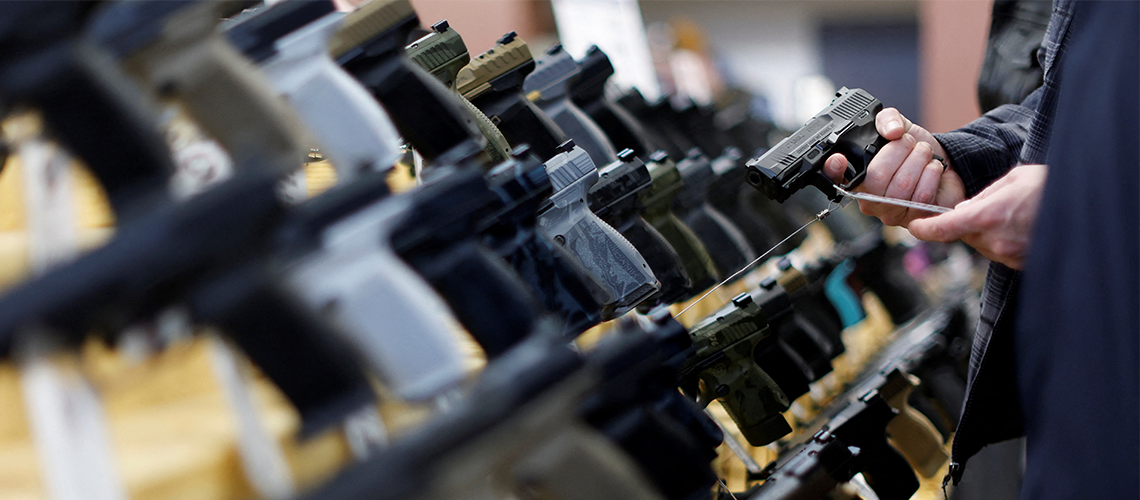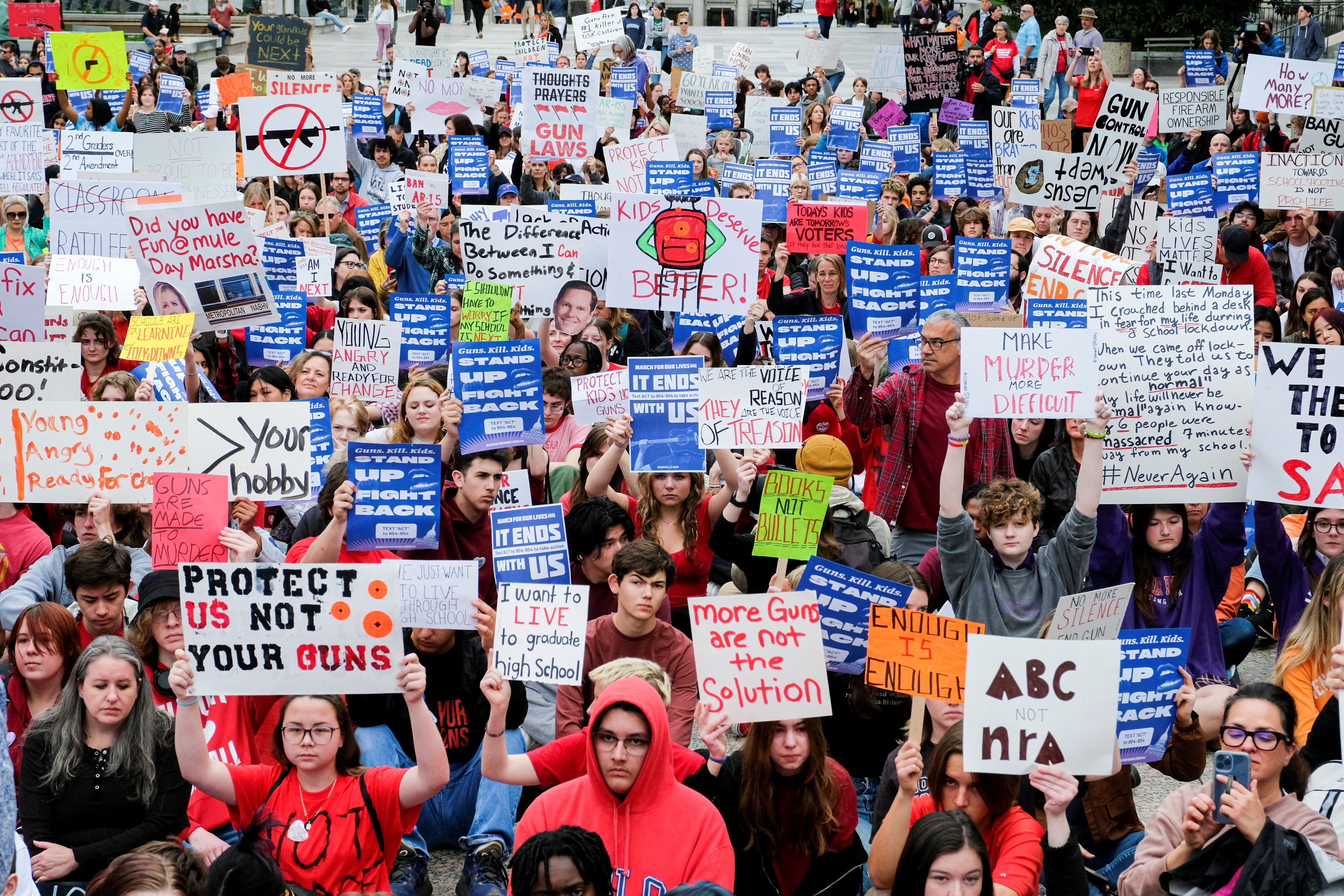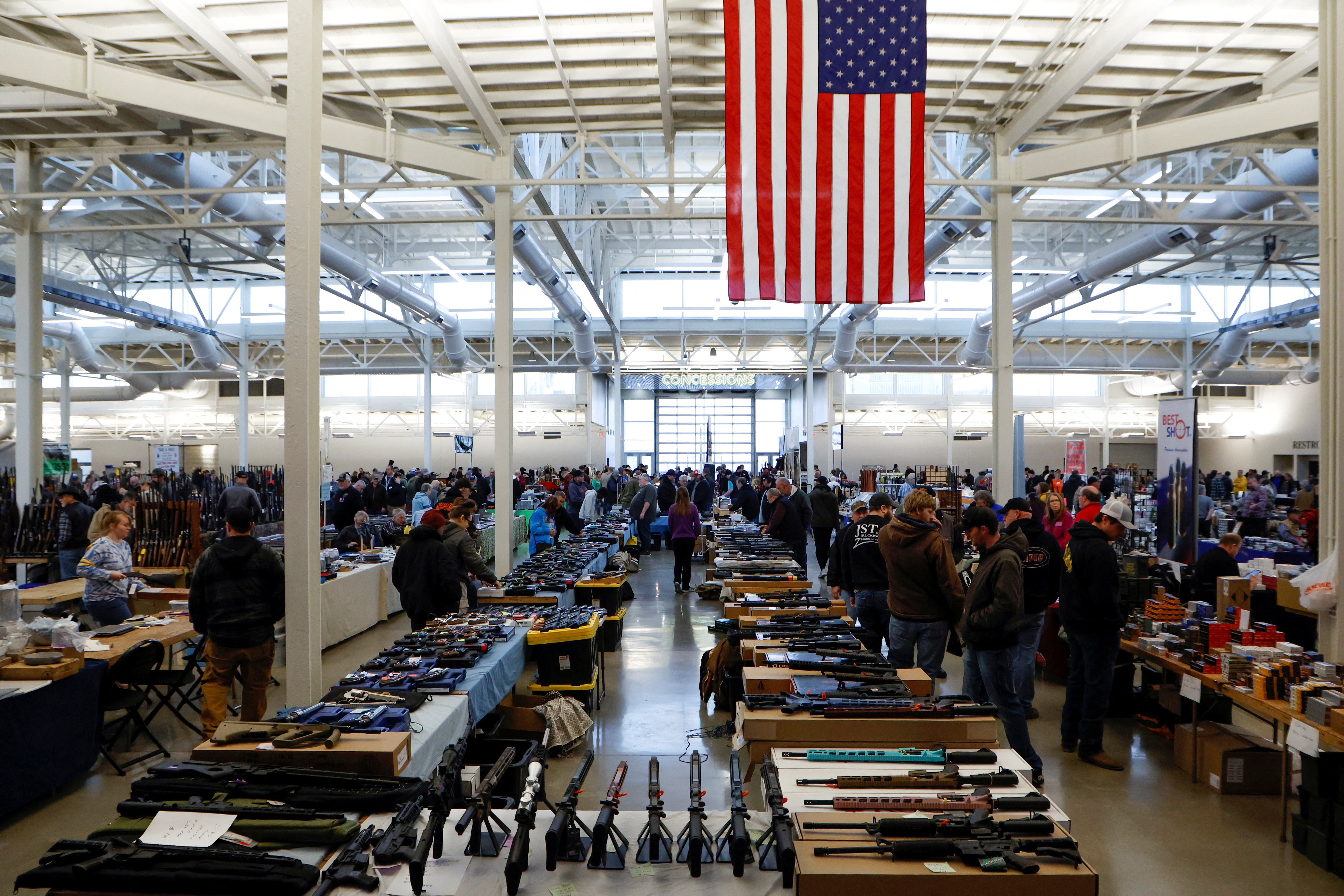America’s gun gridlock
William RobertsFriday 19 May 2023

As gun violence in the US becomes more prevalent than ever, Global Insight reports on how the country is struggling for answers.
A series of mass shootings in the US has drawn national attention and prompted renewed calls for an assault weapon ban and other gun controls. ‘Why in God’s name do we allow these weapons of war in our streets and at our schools?’ President Joe Biden pleaded in a speech on 28 March, a day after six people, including three young children, were killed with an AR-15-style rifle at a private school in Nashville, Tennessee. ‘Those children should all be with us still’, said Biden. ‘As a nation, we owe these families more than our prayers. We owe them action.’
The AR-15 is a semi-automatic version of the M-16 automatic rifle widely used by the US military and is banned for civilians. But AR-style rifles look virtually identical to the M-16 and can be fitted with a high-capacity magazine. They fire shots in rapid succession simply by quick, repeated pulls of the trigger.
“It’s not that there aren’t laws. It’s whether the laws are comprehensive enough and effective
Steven Richman
Vice-Chair of the IBA Bar Issues Commission
Among the dead in Nashville was a teacher who was best friends with the wife of Tennessee Governor Bill Lee. Police released shocking body-worn camera footage of officers hunting down and killing the shooter.
The Nashville school attack on 27 March marked the beginning of the latest string of mass shootings in the US. Days later in Louisville, Kentucky, a 25-year-old man walked into a bank branch where he was employed, carrying an AR-style rifle he had just purchased legally. He killed five people and injured eight others before being slain by police. Among the seriously wounded was a rookie police officer responding to the incident – shot in the head on only his fourth shift. As with the Nashville shootings, the victims were all white and once more, the tragedy struck home for politicians of all stripes and made national news.
Kentucky Governor Andy Beshear, a Democrat, lost a long-time mentor and best friend who was a senior manager at the bank. US Senate Minority Leader Mitch McConnell, a Kentucky Republican who has been a leading bulwark against new gun laws in Congress, issued a statement saying he and his wife were ‘devastated by the news’.
On the same day, a Black man was killed, and a woman injured, by gunfire near a Louisville community college. The incident received little media attention and probably would have gone largely unnoticed had the bank shooting not occurred hours earlier. It served as a telling reminder of the ubiquity of gun violence in US cities. ‘I’ll be honest, caring for three shooting victims, and plus the other that came in, is not an infrequent day for us’, Jason Smith, the Chief Medical Officer at the University of Louisville Hospital, said at a press conference the next day. ‘We barely had to adjust our operating room schedule to be able to do this. That’s how frequently we are having to deal with gun violence in our community.’
Indeed, in 2023, the level of gun violence has reached new heights and is on pace to exceed the previous year’s number of approximately 45,000 deaths and 40,000 injuries. Already in 2023, there have been more than 208 mass shootings – defined as four or more victims killed or wounded. On average, there are between 50 to 100 homicides and deaths every day across the country. As of early May, more than 15,000 people had been killed or died by suicide by guns in 2023 so far, according to the Gun Violence Archive, a non-governmental group that tracks the data. The incidents include an attack by a neo-Nazi at a shopping mall in Dallas; the shooting of five Honduran citizens by a Mexican with an AR-style weapon in San Jacinto County, Texas; and an incident involving a Coast Guard veteran in Atlanta, Georgia, who shot and killed a woman and wounded four others.

People demonstrate in Legislative Plaza to call for an end to gun violence and support stronger gun laws, after a deadly shooting at the Covenant School in Nashville, Tennessee, U.S., April 3, 2023. REUTERS/Kevin Wurm
The Nashville school incident dominated national television news in the US for days, re-energising the debate over guns. Now, after years of inaction, it feels as if there has been a subtle but meaningful shift in the political dynamic that may yield progress, at least at the state level. In Washington, DC, the pre-existing gridlock over guns still likely means nothing significant will be done to deal with the epidemic of gun violence. Lawyers and reform advocates say real progress, as with the campaigns against tobacco smoking and motor vehicle deaths, is likely to take decades.
‘It is challenging because people think there is one single solution, or at least that is what they are looking for’, says Jaclyn Schildkraut, Executive Director of the Regional Gun Violence Research Consortium at the Rockefeller Institute of Government in Albany, New York. ‘But the reality is that gun violence in America is a complex, multidimensional issue that will require a layered approach to address the underlying root causes to improve prevention.’
Why?
Why is this happening? There are an estimated 400 million guns in private hands in the US and these are held by about 40 per cent of households, according to surveys. Following a peak of gun violence during the crack cocaine epidemic of the early 1990s, gun ownership and homicides in the US had been going down. But when the Covid-19 pandemic hit, gun purchases went up and so did the homicide and death rates. ‘The correlation between gun ownership and gun violence is like a straight line’, says Gregg Lee Carter, Professor of Sociology in the Department of Politics, Law, and Society at Bryant University in Smithfield, Rhode Island, who has studied the phenomenon of gun violence in America for decades. ‘If you look at the public health data on having a gun in the house, the risk factors for just an accident, suicides, homicides are enormous’, he adds.
When you ask Americans what their top issues are, gun violence is now much higher than it was in the past. That is a cultural shift
Mary Bernstein
Associate Dean of the Graduate School, University of Connecticut
After a similar wave of mass shootings in 2022, Congress passed the first significant gun safety measure in 30 years, extending background checks and cracking down on straw purchasers – whereby a second person agrees to acquire a firearm for someone else – which represent a major source of illegal guns. The legislation provides $15bn for mental health and school security, red flag laws and local violence intervention programmes. The law was a breakthrough because it won bipartisan support in Congress, but it was limited in scope.
Biden, his allies in Congress and gun control advocates are now calling again for an assault weapon ban as well as laws making high-capacity magazines illegal, enforcing universal background checks, requiring safe storage and ending liability immunity for gun manufacturers. All are politically controversial and draw opposition from the gun lobby, even though public opinion surveys show support for commonsense measures.
The obstacles are political, judicial and cultural, stemming from issues of systemic racism, broken democratic institutions and a popular fetishisation of guns and violence, say lawyers and reform advocates. ‘There are laws on the books. In various of these shootings, lawfully acquired guns are used. This is part of the problem. It’s not that there aren’t laws. It’s whether the laws are comprehensive enough and effective’, says Steven Richman, Vice-Chair of the IBA Bar Issues Commission and a partner at law firm Clark Hill in Princeton, New Jersey. ‘I support strict gun control laws, but I also recognise that the laws on the books are not necessarily going to prevent some of the tragedies. Part of the issue remains cultural and historic.’
Diverging tracks
The Second Amendment to the US Constitution, adopted in 1791 as part of a historic ‘Bill of Rights’, protects the ability of citizens to own weapons. It reads: ‘A well regulated Militia, being necessary to the security of a free State, the right of the people to keep and bear Arms, shall not be infringed’. Many state constitutions have similar protections for gun owners.
The Second Amendment has gained a mythological status. The National Rifle Association (NRA), the US’ largest pro-gun group, has for decades fought fiercely against any proposed laws at the national or state level that would license or restrict gun ownership. That means ‘no’ to expanding background laws, raising the age limit to 21 for gun purchases or limiting magazine capacities.
At the NRA’s 2023 annual meeting, held in Indianapolis just two days after the Louisville shootings, NRA President Wayne LaPierre told the audience that Indiana’s new law, which was enacted in 2022 and allows people to carry concealed handguns without a permit, should be a model for the rest of the country. It’s a trend in Republican-controlled states. Earlier this year, Florida – under Republican Governor Ron DeSantis – became the 26th state to enact a law allowing people to carry guns without a permit. ‘We have this split personality in the American system where we have the shootings and there are calls for tighter gun laws, and one party has a majority [but] there is not always unanimity in either party as to how far they will go’, Richman says.
Recent US Supreme Court interpretations of the Second Amendment have made implementing stricter gun control laws at state level more difficult. The Court’s new 6-3 conservative majority last year struck down a New York State law that required gun owners to demonstrate a reason why they should be allowed to carry a concealed weapon. ‘Because the State of New York issues public-carry licenses only when an applicant demonstrates a special need for self-defence, we conclude that the State’s licensing regime violates the Constitution’, wrote Justice Clarence Thomas for the majority in deciding New York State Rifle & Pistol Association Inc. v Bruen.
There will always be violence and gun deaths but there’s equally no doubt the types of laws that are being debated are helpful in protecting more people
Robert Spitzer
Adjunct Professor, College of William and Mary School of Law
The Court may soon review Illinois’ ban on assault weapons and a newly adopted assault weapons ban in Washington state. The Court’s new activism around guns is raising concern because it threatens to change patterns of practice that have largely kept gun usage under control. Historically, US jurisprudence has developed to allow a balancing of the gun ownership rights against public safety and local control, enabling states and cities to enact reasonable regulations. Thus, even where many states permit broad access to gun ownership, the places and manner in which those guns can legally be carried and used is often prescribed. In most places in the US, a law-abiding gun owner who wrongfully discharges, or even brandishes, a weapon can be subjected to a range of criminal and civil penalties.
‘We are at kind of a dilemma moment in the sense that the country is seems to be proceeding to diverging tracks’, says Robert Spitzer, Adjunct Professor at the College of William & Mary School of Law in Virginia. ‘On the one hand, most Americans favour stronger gun laws. Most gun owners support the ideas for stronger gun laws that are being discussed, generally. Several more liberal states have strengthened their laws, whereas more conservative states have been deliberately going in the other direction. And you have the Supreme Court in particular […] certainly expanding the definition of gun rights.’
The rise of advocacy
In one surprising recent survey by the University of Texas, 76 per cent of those polled in Texas support raising the legal age limit to buy a gun from 18 to 21. Only 20 per cent of Texas voters surveyed oppose raising the age limit. A bill is now advancing in the Texas legislature to set 21 as the legal limit to buy an AR-style weapon, despite vocal opposition by the state’s Governor, Greg Abbott.
In Tennessee, Governor Lee has called for a special legislative session in August to address public safety and gun control. ‘There is broad agreement that action is needed, and in the weeks ahead, we’ll continue to listen to Tennesseans and pursue thoughtful, practical measures’, Lee said.
Counterbalancing the power of the NRA and the gun lobby in America has been the rise of advocacy groups such as Sandy Hook Promise, Moms Demand Action and Everytown. These organisations are giving people touched by gun violence new platforms to organise and address policy issues at the state and local levels. ‘The national conversation has shifted’, says Mary Bernstein, Associate Dean of the Graduate School and professor of sociology at The University of Connecticut. ‘When you ask Americans what their top issues are, gun violence is now much higher than it was in the past. That is a cultural shift, a sign that things may be changing, although it may not be anytime soon. But that really matters.’
A Fox News poll after the mass shootings in April found large majorities of Americans support gun control measures. For example, 87 per cent supported universal background checks for gun purchases and 81 per cent were in favour of raising the legal age for purchases to 21. The other measures highlighted in the survey were requiring mental health checks, mandating a 30-day waiting period and enacting ‘red flag’ laws that allow police to confiscate guns from people posing a danger to themselves or others – and all received strong support. ‘With so many guns in the country there is no single magic solution. And then there will always be violence and gun deaths but there’s equally no doubt the types of laws that are being debated are helpful in reducing those numbers and protecting more people’, Spitzer says.
What works
With the debate over guns so highly polarised at the national level, the prospect of meaningful firearms regulations coming from Congress is limited. US lawmakers reached what is likely to be the closest to bipartisan consensus available to them when they passed the Safer Communities Act in 2022. The lack of further Congressional action ‘puts the onus on states, which means that there is considerable variability between restrictive and permissive laws in place’, Schildkraut says.

Customers attend the Des Moines Fairgrounds Gun Show at the Iowa State Fairgrounds in Des Moines, Iowa, U.S. March 11, 2023. REUTERS/Jonathan Ernst
Evidence suggests that gun permits and bans on large capacity magazines can reduce mass shootings with assault weapons, which are far more deadly than attacks using standard semi-automatic handguns. Meanwhile, research shows there is a predictable path of escalation for most mass shooters from grievance to violent ideation, to planning and preparing an attack, before they finally act.
Red flag laws that allow authorities to intervene with individuals who may be struggling psychologically can help. A 2019 report by the US Secret Service found that 75 per cent of school shooters communicated their violent intent ahead of the attack, giving people around them an opportunity to prevent it. Likewise, many domestic violence gun deaths can be predicted and prevented. An estimated 60 women a month are killed by their intimate partners in the US. Civil protection orders that provide for removal of firearms work in domestic violence situations.
Frustrated by the inability of government to stop the epidemic of killing, more and more reformers are seeking to work at a people-to-people level. One such group is Stand SAFE, founded by Dean Winslow and Julie Parsonnet, a husband-and-wife team at Stanford Health Care in California. Winslow is a former US Air Force flight surgeon who witnessed first-hand the damage assault weapons do to human beings while deployed to Afghanistan and Iraq. ‘Many times, sadly, we weren’t able to save the life of a soldier or marine or an airman who was shot by an assault weapon’, he says.
Winslow and Parsonnet are now educating medical professionals, who are often in direct contact with shooting victims and their families, about how to talk about gun safety and violence prevention. ‘Getting doctors sophisticated enough that they have credibility with patients when they talk to them about safe storage of weapons, in households with children or elderly people, or people with mental health problems, is a real place where we can make a difference’, Winslow explains.
For Parsonnet, there exists ‘a culture of fear in the United States where we see a lot of gun violence and it’s creating a feeling that you need to get a gun because everybody has one. We have to shift that culture and show that having a gun does not actually make one safer and there is not so much reason to be fearful’.
William Roberts is a US-based freelance journalist and can be contacted at wroberts3@me.com
Image credit: Customers shop at the Des Moines Fairgrounds Gun Show at the Iowa State Fairgrounds in Des Moines, Iowa. REUTERS/Jonathan Ernst
